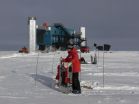(Press-News.org) Analysis of the longer-term influence of menopausal hormone therapy on breast cancer incidence in two Women's Health Initiative (WHI) clinical trials suggests a pattern of changing influences over time on breast cancer, according to an article published online by JAMA Oncology.
Use of menopausal hormone therapy decreased dramatically after reports of increased breast cancer risk with estrogen plus progestin from the WHI randomized clinical trial followed by the Million Women Study observational analysis. Following the initial WHI reports, decreases in both combined estrogen plus progestin use as well as estrogen alone use were seen. However, in the WHI randomized trials, while estrogen plus progestin increased breast cancer incidence and breast cancer deaths, estrogen alone in women with prior hysterectomy significantly reduced breast cancer incidence and breast cancer deaths. Those results raised questions about the short- and long-term postintervention effects of these two regimens on breast cancer.
Rowan T. Chlebowski, M.D., Ph.D., of the Los Angeles Biomedical Research Institute at Harbor-UCLA Medical Center, Torrance, Calif., and coauthors examined early and late postintervention effects on breast cancer in the two WHI hormone therapy trials with a current median follow-up of 13 years.
A total of 16,608 women with a uterus were assigned to receive oral conjugated equine estrogens (0.625 mg/d [estrogen]) plus medroxyprogesterone acetate (2.5 mg/d [progestin]) or placebo with a median intervention of 5.6 years, and 10,739 women with prior hysterectomy were assigned to receive the estrogen alone or placebo with a median intervention of 7.2 years.
In the estrogen plus progestin trial, the increasing breast cancer risk seen during the intervention while women were receiving the combined hormones was followed by a substantial drop in risk in the early postintervention period (within 2.75 years from intervention) when hormone therapy was discontinued but a sustained higher breast cancer risk remained during the late postintervention period years after the therapy was stopped, according to the results.
In the estrogen alone trial, the reduced breast cancer risk seen during the intervention when women were receiving the estrogen lasted through the early postintervention phase but was lost during the late postintervention follow-up, the results show.
"The ongoing influences on breast cancer after stopping hormone therapy in the WHI trials require recalibration of breast cancer risk and benefit calculation for both regimens, with greater adverse influence for estrogen and progestin use and somewhat greater benefit for use of estrogen alone," the article concludes.
(JAMA Oncol. Published online April 16, 2015. doi:10.1001/jamaoncol.2015.0494. Available pre-embargo to the media at http://media.jamanetwork.com.)
Editor's Note: An author made conflict of interest disclosures. The authors made funding/support disclosures. Please see the article for additional information, including other authors, author contributions and affiliations, financial disclosures, funding and support, etc.
Editorial: Progesterone Exposure and Breast Cancer Risk
In a related editorial, Rama Khokha, Ph.D., of the Princess Margaret Cancer Centre, Toronto, Canada, and coauthors write: "Emerging detailed analyses from the WHI trials such as that reported by Chlebowski et al reveal new compelling evidence for the significance of progesterone in breast cancer where it has traditionally taken a back seat to estrogen. ... Although the WHI trials relate to the menopausal setting, lessons learned from them continue to provide additional value in appreciating a potential role of progesterone even in premenopausal breast cancer. Furthermore, investigation into the cellular and mechanistic underpinnings of progesterone's impact on the normal breast and breast cancer may provide new opportunities for knowledge translation and therapeutic intervention in breast cancer."
(JAMA Oncol. Published online April 16, 2015. doi:10.1001/jamaoncol.2015.0512. Available pre-embargo to the media at http://media.jamanetwork.com.)
Editor's Note: Authors made funding/support disclosures. Please see the article for additional information, including other authors, author contributions and affiliations, financial disclosures, funding and support, etc.
INFORMATION:
Media Advisory: To contact corresponding author Rowan T. Chlebowski, M.D., Ph.D., call Laura Mecoy at 310-546-5860 or email Lmecoy@labiomed.org. To contact corresponding editorial author Rama Khokha, Ph.D., call Jane Finlayson at 416-946-2846 or email jane.finlayson@uhn.ca.
Obesity was associated with an increased risk for prostate cancer in African American men and that risk grew by nearly four times as body-mass index (BMI) increased, according to an article published online by JAMA Oncology.
African American men have the highest incidence of prostate cancer of any racial or ethnic group in the United States, as well as the highest rates of aggressive disease and prostate cancer death. These elevated risks likely arise from both social and biologic factors. The associations of obesity with prostate cancer risk are complex.
Wendy E. Barrington, ...
Advice on preventing and treating venous thromboembolism (VTE) during pregnancy, birth and following delivery is outlined in two new revised guidelines published today (13 April) by the Royal College of Obstetricians and Gynaecologists (RCOG) and launched at the RCOG World Congress in Brisbane, Australia.
VTE refers to the formation of a clot within veins. This can occur anywhere in the venous system, but the predominant sites are in the vessels of the leg (giving rise to deep vein thrombosis (DVT)) and in the lungs (resulting in a pulmonary embolism (PE)).
The Green-top ...
Two primatologists working in the forests of the Republic of Congo have returned from the field with a noteworthy prize: the first-ever photograph of the Bouvier's red colobus monkey, a rare primate not seen for more than half a century and suspected to be extinct by some, according to WCS (the Wildlife Conservation Society).
The elusive primate was recently photographed by independent researchers Lieven Devreese and Gaël Elie Gnondo Gobolo within Ntokou-Pikounda National Park, a 4,572-square-kilometer (1,765-square-mile) protected area created on advice from WCS ...
COLUMBIA, Mo. - Discussing end-of-life wishes with loved ones can be difficult, but new research from the University of Missouri shows more individuals are engaging in advance care planning. Advance care planning includes discussing end-of-life care preferences, providing written end-of-life care instructions and appointing a durable power of attorney for health care.
"Advance care planning increases the likelihood that the care one receives at the end of her life is congruent with what she wants," said lead author Nidhi Khosla, an assistant professor of health sciences ...
This news release is available in French. Many potentially efficient drugs have been created to treat neurological disorders, but they cannot be used in practice. Typically, for a condition such as epilepsy, it is essential to act at exactly the right time and place in the brain. For this reason, the team of researchers led by Christophe Bernard at Inserm Unit 1106, "Institute of Systems Neuroscience" (INS), with the help of scientists at the École des Mines de Saint-Étienne and Linköping University (Sweden) have developed an organic electronic micropump ...
Fairfax, Va., April 16, 2015--The "Radiation and the Modern Management of Lymphoma" issue (May 1, 2015) of the International Journal of Radiation Oncology * Biology * Physics (Red Journal), the official scientific journal of the American Society for Radiation Oncology (ASTRO), is focused on the integral role of radiation therapy in current lymphoma treatment. May 2015 marks 50 years since the first multidisciplinary lymphoma conference, "La Radiotherapie de la Maladie de Hodgkin," was held in Paris in 1965, which led to a more comprehensive understanding of the cancer's ...
Older adults who keep a clean and orderly home--because of the exercise it takes to get the job done--tend to feel emotionally and physically better after tackling house chores, according to new findings by a Case Western Reserve University school of nursing researcher.
"House cleaning kept them up and moving," said Kathy D. Wright, PhD, RN, CNS, a postdoctoral KL2 Scholar at the university's Frances Payne Bolton School of Nursing. "A clean environment is therapeutic."
Wright and a research team set out to test a theory called House's Conceptual Framework for Understanding ...
CHICAGO (April 16, 2015): People with limited education and low income have higher odds of death within 30 days after undergoing an operation for lung cancer than those who are more educated and financially better off, according to new research published as an article in press on the website of the Journal of the American College of Surgeons in advance of print publication later this year.
"In order to get uniform superior outcomes for our patients, we need to identify the patients who are at risk for worse outcomes," said study co-author Felix G. Fernandez, MD, FACS, ...
A concentrated extract of maple syrup makes disease-causing bacteria more susceptible to antibiotics, according to laboratory experiments by researchers at McGill University.
The findings, which will be published in the journal Applied and Environmental Microbiology, suggest that combining maple syrup extract with common antibiotics could increase the microbes' susceptibility, leading to lower antibiotic usage. Overuse of antibiotics fuels the emergence of drug-resistant bacteria, which has become a major public-health concern worldwide.
Prof. Nathalie Tufenkji's research ...
Neutrinos are a type of particle that pass through just about everything in their path from even the most distant regions of the universe. The Earth is constantly bombarded by billions of neutrinos, which zip right through the entire globe, houses, animals, people - everything. Only very rarely do they react with matter, but the giant IceCube experiment at the South Pole can detect when there is a collision between neutrinos and atoms in the ice using a network of detectors. New research results from the Niels Bohr Institute among others have measured the neutrinos at the ...

